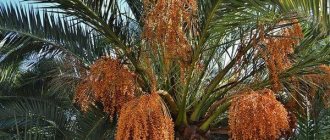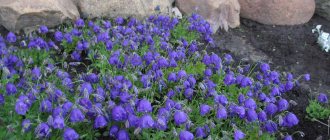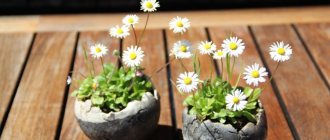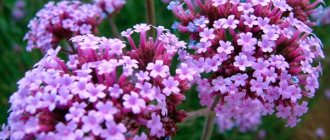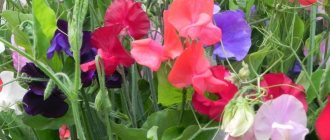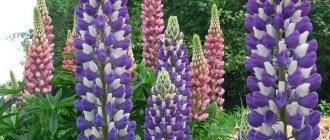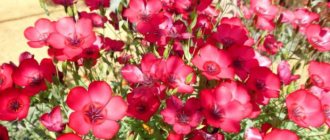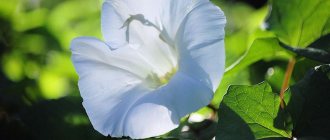Verbena is a beautiful and unpretentious plant with which you can create an amazing and bright flower garden. Now the most popular varieties are: Buenos Aires (Bonar), hybrid, straight, hard, Canadian. The flower is perennial, but in our country it is most often grown as an annual. If you want to contemplate a beautiful flower bed at your dacha or the site of a private house, then now is the time to start growing verbena from seeds at home.
General information about the plant
Verbena is a wild plant in tropical and subtropical regions of the American continent. There are more than 200 species in the verbena family. Hybrid verbena is used for garden cultivation and landscape design. This is a group of perennial shrubs bred by breeders for ornamental cultivation.
Ampelous verbena vegetative variety Mix amazes with its variety of shades
Main features of verbena:
- tetrahedral pubescent shoots;
- carved leaves (grouped at the bottom; there are varieties with oblong, lance-shaped, triangular, heart-shaped leaf blades);
- the buds are collected in dense caps, after flowering they form seed crusts;
- developed root system (depending on the height of the bush, it goes 15–15 deep into the soil
25 cm);
- high productivity (there are up to 12 peduncles on one plant);
- duration of flowering (from mid-June to late September).
There are erect and creeping varieties. Nurseries often offer a flower mixture, in one package plants with red, blue, peach, blue inflorescences.
Important! A perennial crop in temperate latitudes is grown as an annual crop. Only the only tall variety Amulet overwinters well under cover.
The height of hybrids varies from 10 to 50 cm. There are:
- ground cover creeping varieties with shoots up to 60 cm long;
- dwarf up to 15 cm tall, with small flower caps;
- ampelous large-flowered, growing in flowerpots, pots, hanging baskets (characterized by long-lasting flowering, decorate home winter gardens until late winter);
- medium-sized with erect shoots up to 30 cm;
- tall, resistant to lodging.
By the way, well-branched varieties are called vegetative verbena. They are propagated by cuttings. Seed species are usually called species with erect, strong stems, elongated buds, forming large seed pods.
Characteristics of the variety
The name hybrid verbena (Verbenahybrida) combines numerous garden forms and varieties of hybrid origin. It is an annual or perennial plant 10-50 cm high. Leaves: 1-6.5 cm long, opposite, alternate, pinnately incised, often three-lobed with small lateral lobes.
Flowers: small 1.5-2.5 cm in diameter, collected in 30-50 pieces. into corymbose inflorescences. The corolla is five-lobed and two-lipped. The calyx is 3-4 mm long, five-toothed, hard-hairy.
Stems: slightly spread, erect, stiffly pubescent. Fruits: light brown nuts, collected from four parts , each 2-2.5 mm long, converging at the base of the calyx.
Use in garden design
Verbena Buenos Aires (Bonar)
Hybrid varieties, having a compact root system, get along well with other plants:
- cereal and bluegrass herbs;
- petunia;
- geranium;
- juniper and other conifers.
Creeping verina
The following varieties are traditionally used to decorate a site:
- “Ideal” is distinguished by early flowering, the color of the caps is cherry, pink, red, white, blue, lilac;
- “Star dance” of all kinds of flowers, the buds have a colored center (ampelic, drought-resistant verbena);
- “Carousel” is a medium-sized shrub that looks like a primrose (white, blue, purple, pink, red colors are available, there are varieties with a colored eye);
- “Fancy” is a tall verbena that forms a dense bush due to numerous side shoots.
The search for a variety is not limited to this list. Large-flowered “Etna”, “Julia”, “Cardinal” look gorgeous in flower beds. For balconies choose compact types “Crystal”, “Dazler”, “Amethyst”.
Important! When choosing a variety, the main criterion is the height of the plants. Combining dwarf, low-growing and tall verbenas they create amazingly beautiful borders near buildings and steam paths.
general description
Verbena is a herbaceous plant with highly branching stems that was distributed from South America throughout the world. The bush can grow in height from 20 cm to a meter, and under particularly favorable conditions - up to one and a half meters. In tall varieties, the stems are straight and elongated, while in medium and low forms they can be creeping. Sometimes the shoots become leafless, leaving only inflorescences at the tops.
The leaf blades are small or medium in size and may be covered with shaggy hairs. The root system is shallow, due to which the species cannot withstand frosts below -3ºС, therefore it is not capable of overwintering without shelter in frosty winter conditions.
Flowering occurs very densely and abundantly; the bush can form a bright ball, on which the stems and leaves are not visible through the inflorescences. Flower colors are presented in a wide palette ranging from white to bright pink and lilac shades. There are forms with uneven coloring or a white spot inside.
Propagation of verbena by seeds
Verbena, what is it: yellow, herb, perennial or annual
The plant has a long growing season; if you immediately sow the seeds in open ground in bad weather conditions or rainy summers, you won’t be able to wait for flowering. It is better to sow the seeds in advance at home or in a greenhouse. If you do this in the second decade of March, verbena will produce buds in June.
There is one caveat: like all hybrids, verbena planted with seeds does not always inherit the best characteristics of the species. “Wild ones” with a cone-shaped inflorescence can grow.
There is no point in collecting planting material yourself. It is better to purchase it in bags - this is a guarantee that the plant will delight you with lush caps.
How to prepare planting material for sowing
The issue of seed preparation is usually not a pressing issue. For example, purchased seeds packaged in bags are immediately ready for planting (but it is advisable to first soak them and treat them against infections and fungi).
ON A NOTE. In open ground, Verbena is able to reproduce independently - by self-sowing. Or you can carefully collect the seeds, which appear in small brown or light green nut-like fruits.
Seeds collected on your own can be stored for up to 5 years. During this time, they practically do not lose their germination capacity. They need to be stored in a dry place, away from light. It is optimal to collect them in an opaque bag and put them in a dry cabinet.
Growing from cuttings
Cuttings will help preserve your favorite variety until next spring. They are harvested in the fall before frost sets in. Up to 6 leaves are left on each. After two or three days in water, the shoots grow roots. It's ready to land. Verbena is rooted in a mixture of peat and sand, buried to the point of growth of the lower leaves. In a month, a powerful root system will form. Buds will appear by the New Year. By spring planting, the tops of the shoots are again separated from the wintering house.
Before pruning the cuttings, the instrument is disinfected so as not to introduce a putrefactive infection. The youngest shoots are chosen.
Important! The cutting will take root faster if tropical conditions are created for it: cover the top with a piece of plastic bottle or make a shelter from a plastic bag.
Dates for planting verbena seedlings in 2022
When is the best time to plant verbena, in what month? The suitable time for sowing seeds for seedlings is March . But you can sow in February , but in this case it is necessary to provide additional light to the plants.
Very often, when choosing a time for planting at home, many experienced summer residents use the lunar calendar, which tells which days are suitable for the procedure and which are not. Thus, according to the Lunar calendar 2022, it is better to sow verbena as follows:
- Favorable days: in January: 1, 10, 11, 15, 16, 19, 20;
- in February: 7, 8, 12, 13, 14, 15;
- in March: 10, 11, 15, 20, 21, 24, 25.
- Unfavorable days: in January: 2, 18th;
- in February: 1, 16;
- in March: 2, 16, 17, 18, 31.
How to grow verbena seedlings
For planting seeds, choose loose soil seasoned with humus and sand. It should be neutral. A universal soil mixture will do. The seed material is placed immediately into an individual pot or a common planting container.
A little step-by-step instructions:
- the soil is leveled and lightly pressed down;
- the seeds are laid out on the surface of the ground, do not press down;
- wet the surface well using a spray bottle or watering can with a fine-jet nozzle;
- there is no need to fill the seeds on top; the planting container is covered with film or covered with glass;
- put in a warm place for germination (optimal temperature +25°C), lighting is not necessary (in two days the seeds will swell and hatch, seedlings will appear in 6–7 days);
- emerging shoots are exposed to light, recommended mode is +15…+17°C;
- Picking into individual containers is carried out after the appearance of the 4th leaf.
When sprinkling, water is distributed evenly. The spread out seeds will remain in their place
A few growing tips:
- hybrid verbena bushes, when grown from seeds, will stretch less if the plant is illuminated with a diode lamp, extending the daylight hours to 14 hours;
- the seeds will sprout evenly if they are held in a growth stimulant solution before spreading;
- Moderate watering is needed, root rot develops from stagnant water;
- 2 weeks before planting on the plot, the seedlings are hardened: they are placed in a cool place for several hours, the time interval is gradually increased.
Make drainage in plastic glasses, fill the container to ¼ of the height with fine expanded clay or sand
Well-hardened seedlings will not die if there is an unexpected nighttime cold snap down to -3°C. Plants are transferred to open ground after return frosts, when night temperatures reach +10°C. Planting is carried out using the “transshipment” method while preserving the earthen clod. For verbena, choose well-lit areas of the garden with neutral, loose soil. It is advisable to add wood ash, fluff or dolomite flour before planting at the rate of 1 cup per 1 m2.
Important! It is not recommended to thicken the plantings; the distance between the holes is left from 30 to 50 cm, depending on the variety of verbena.
Plant care
In temperate climates, verbena is planted in open ground in May, in the northern regions in June. Most species are able to tolerate short-term frosts down to -3°C.
Plants do best in sunny areas in slightly acidic soils. Some species of North American origin prefer alkaline soils and require liming of the soil.
Verbena is very unpretentious to soil fertility; it can grow even on poor soils. Even if the soil is sandy or rocky, this has virtually no effect on the intensity of plant growth and the abundance of its flowering.
Verbena requires minimal care
It is even recommended to dilute heavy clay soils with sand to ensure greater soil looseness.
The distance between plants when planting should be at least 20 cm, since the bushes of the plant will almost always be spreading. Taller varieties should be spaced 30-40 cm apart.
Sometimes drainage is used for verbena in the form of pebbles, crushed stone or broken brick placed at the bottom of a hole (10-14 cm deep). Planting is best done in cloudy weather or in the evening. Watering the plant after planting is advisable, especially in dry climates.
For the first month, the plant needs moderate regular watering, but it is better to avoid stagnation of water. Adult plants do not need to be watered, except during particularly dry summers.
The plant requires virtually no care, but for abundant flowering, you can fertilize it several times a season. Traditionally, mineral fertilizers are used, mainly phosphorus-potassium fertilizers.
Verbena does not need nitrogen fertilizing, since the growth of the green part of the plant always occurs without problems. Excess nitrogen can cause the green part to grow into impenetrable bushes, but flowering will be very weak.
It is recommended to loosen near verbena bushes 2-3 times per season and remove weeds near young plants. Mature plants are able to take care of themselves, since the plant is quite aggressive and grows quickly.
Flowering plant
The flowering of verbena can be significantly extended by removing faded parts of the inflorescences. This will lead to the formation of new flowers. A similar procedure is also used to prevent the plant from reproducing by self-seeding.
The stems tolerate pruning well; it allows not only to give the plant the necessary shape, but also allows the stems to branch even more and lay new inflorescences.
Verbena is a light- and heat-loving plant with low frost resistance (only a few species can be grown in temperate climates as perennials), so verbena does not tolerate winter in our conditions.
At the end of autumn, it is necessary to cut off the stems of the plant and dig up the area itself. Before wintering, frost-resistant perennials are cut to a level of 5-6 cm above the ground and covered with a layer of fallen leaves.
Verbena can also be grown as an ampelous plant in flowerpots or flower pots. The root system of verbena is small in size, so growing it in limited volumes of soil does not affect the quality of life of the plant. For the winter they should be brought into warm rooms.
Thanks to the large number of chemically active substances inside the stems and leaves of the plant, verbena is practically immune to the effects of viruses and fungi. And insect pests avoid the plant due to its aroma.
On the other hand, the pleasant aroma of verbena attracts bees, which is often used by gardeners and beekeepers.
Care, watering and fertilizing
The plant does not require constant care. It is enough to water the flower during dry periods. If there is an excess of moisture, fungal infections develop; if there is too little, when the earthen ball dries out, seed pods are actively formed, and new buds are not formed. During periods of heavy rain, drainage or drainage is provided so that water does not stagnate at the roots. Verbena will not grow in flooded areas.
Now about feeding. During the growth period, the bush needs nitrogen, when buds are laid - other microelements: potassium, calcium, phosphorus. Fertilizers are applied no more than once a month. With an excess of fertilizers, the plant is inhibited.
Pests and diseases
Among the diseases to which hybrid verbena is most often susceptible are root rot, gray rot, and powdery mildew.
When infected with root rot, the leaves and stems of verbena turn yellow
When affected by gray rot, dark gray spots appear on the leaves, the inflorescences rot and fall off
Powdery mildew appears as a thick white coating on leaves and inflorescences
The listed fungal diseases of verbena are the result of violation of watering rules. Modern fungicides are used as the main means of plant treatment.
In addition to diseases, during the summer season hybrid verbena can be attacked by some pests: thrips, spider mites, aphids.
Thrips suck out healthy juices, gray spots appear at puncture sites
The spider mite is “located” on the lower part of the leaf blades, its habitats are “marked” with a characteristic web
Aphids are the most dangerous pest that feeds on plant sap and slows down the growth and flowering of verbena.
Processing beds
An important condition is regular weeding. Weeds quickly become woven into the root system of plants; it is impossible to remove them without damaging the flower bush. Loosening is necessary for access to oxygen and evaporation of excess moisture.
By the way, peat will help to avoid the appearance of crust on clay soils. It is poured in a layer of up to 5 cm. It performs the function of mulch - it retains moisture.
To cultivate the soil, it is better to use paddle rippers; they damage the root system less.
Basic nuances of care
With correct planting of verbena and high-quality care, the plant will bloom profusely from the end of May until the end of October inclusive; the inflorescences are distinguished by their attractiveness; you can appreciate their tenderness and beauty from numerous photos of flowers.
Regardless of the growing conditions for verbena (outdoor/indoor), you need to provide the plant with ideal conditions:
- the temperature should vary in the range of 22–28 degrees; if it increases significantly, experienced gardeners advise covering the verbena with a light cloth or temporarily moving it to the shade;
- the same applies to lighting; scorching sun rays can lead to rapid drying of the soil and leaves;
- complex fertilizer is applied once every 2–3 weeks throughout the entire flowering period;
- water the verbena after the top layer of soil has dried; it is not recommended to spray the leaves and top;
- after watering, loosen the soil - this improves root aeration;
- to prolong the flowering period, faded inflorescences are torn off;
- If necessary, you need to trim overgrown shoots, this will help to form an attractive flower head.
Verbena in a composition with petunia in a hanging pot
Preserving verbena in the house in winter
The flower will overwinter on a glazed loggia, insulated balcony or winter garden at temperatures up to +15°C. It is advisable to plant bushes in containers for wintering before the cold weather. The stem is shortened to 10 cm. The earth must be regularly moistened so that the earth does not crack. The plant is kept in the dark for a month at the very beginning of spring. After this, they take it out into the light, loosen it, and feed it. By the onset of warm days, the bush will be ready to be moved to the site. Cuttings are taken from overwintered hybrids for vegetative propagation.
Transfer
For verbena, a light to medium soil substrate is suitable, composed of leaf, peat, humus soil and partly sand.
- Before replanting, you can disinfect the soil with any fungicide to protect against fungal diseases.
- Plants should be replanted in dry or slightly moist soil, since the root system is not injured and will take root well with subsequent watering.
- In pots (plant pots), cover the drainage hole with a layer of small river pebbles and fill the container with soil mixture.
- After everything is ready for replanting, the plant is carefully removed from the previous substrate, the rhizomes are inspected, and damaged areas are removed. After this, the plant is lowered into the soil poured into the pot and covered so that the root collar is slightly lower from the edge of the pot and is not covered with soil.
- A newly planted plant should be watered sparingly.
- Basic rules for caring for a young plant require bright lighting for 8-10 hours a day and good air circulation.
Hybrid verbena diseases
With proper care, the plant does not get sick. Fungicides are used for powdery mildew and root rot. Spider mites are killed by acaricides, while aphids are afraid of insecticidal treatment.
Attention! Aphids are carried by small black ants. After they appear on the site, it is better to immediately sanitize the flowers with biological products.
By following the basic rules of agricultural technology and creating comfortable conditions for verbena, you can admire the beautiful inflorescences for a long time. Every year new hybrid varieties appear, striking in color. Verbena is good as an independent plant and part of a single landscape composition.
What plants does it go with?
Verbena can be planted alone or combined with other crops on the site. The best neighbors for the plant are:
- ornamental cereals;
- marigolds and asters;
- sage and echinacea;
- petunia and bronze fennel;
- heliotrope and cineraria.
When creating an artistic composition, it is necessary to ensure that the plants have the same requirements for conditions and care. It is recommended to use hybrid verbena to create flower beds and low borders.
Hybrid verbena is usually short in stature, so it is planted in the foreground of flower beds
Pros and cons of the method
Typically, verbena, both annual and annual, is planted through seedlings. It has a weak point - a low level of frost resistance, so in open ground the plant may not germinate or severe frosts will damage the root system and prevent further development.
The method of growing seedlings has several significant advantages:
- Seedlings allow you to get healthier, more beautiful plants that can take root in open ground.
- Easy to grow and care for. The gardener does not require any special skills or experience.
- The ability to create a unique composition from several varieties. Experienced gardeners can even create different designs or patterns.
The only disadvantages of the seedling method include the additional costs of purchasing cassettes, soil, and various mineral mixtures for bait.
When to plant depending on the region?
In most of Russia, Ukraine, and Belarus, Verbena seeds are planted to grow seedlings throughout March. Only a few, the most experienced gardeners begin work in February. They do this so that at the beginning of May, and sometimes even in April, they can observe the flowering of this plant in their open garden. However, it is important to remember that you should only replant bushes when there is no frost at night. If, according to forecasts for the middle zone, the onset of stable spring heat is expected in April, then you can start growing seedlings early.
REMEMBER that in February in the middle zone, seedlings may still not have enough light, and Verbena is a light-loving plant. The solution is to organize artificial additional lighting for 4-8 hours a day (up to 12 hours of daylight are needed in total).
In the south of Russia and Ukraine, Verbena seeds are usually planted at the end of February and less often at the beginning of March. This is because already in April it is warm and light enough for the plant to be safely transplanted outside.
But in the northern regions the deadlines are expected to come later. To the north of the Moscow region, as well as in the Urals and most of Siberia, these flowers are sown in early April in order to be replanted in May-June, when more or less stable weather sets in without temperature changes for growing flowers.
Landing
Produced at the end of spring, when warm weather sets in. At this time, verbena seedlings are planted in a permanent plot. The place should be well lit throughout the day so that the light-loving beauty feels comfortable. You cannot plant a hybrid species in lowlands where moisture flows after rain or in wetlands. The plant is a drought-resistant species that does not tolerate constant dampness.
Read more about planting perennial verbena and growing the plant here.
Land preparation
The flower does not have any special requirements for the composition and reaction of the soil, but feels better on fertile loamy soil with a loose structure.
Heavy dense soil is mixed with sand and peat, and drainage from any stones is laid at the bottom of the planting hole. This will protect the roots from stagnation of water and rotting.
The soil must be mixed with humus and mineral fertilizers containing potassium and phosphorus. Bushes are planted in this nutrient mixture and the soil around is lightly compacted.

